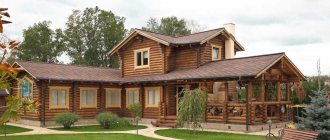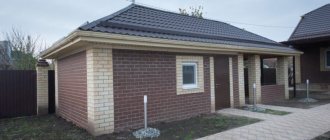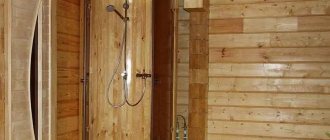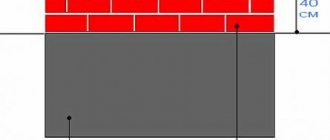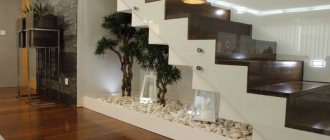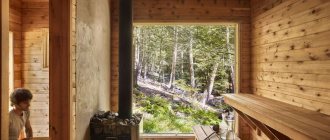Project of a bathhouse with a gazebo, on the territory of which there is a barbecue area. Teplokrepost Photos
What to call a “gazebo attached to a bathhouse”? Let's be clear at the very beginning: we will call a gazebo a separate (!) standing light building with a roof and a fence, inside of which there are (at a minimum) seats for relaxation (table, barbecue, barbecue - optional).
It is acceptable that such a structure may be located in close proximity to the bathhouse and connected to it by a small passage. The roof can be made as a single unit with the roof of the bathhouse.
But if this same structure completely merges with the bathhouse, having supports on one or two of its walls, we advise you to read materials about the terrace or veranda or pool.
Of course, we cannot prohibit calling a terrace or veranda a “gazebo,” but when describing the various options, we must adhere to at least some terminological rigor. Please understand and choose what best suits your interests: gazebo, veranda, terrace.
Initially, gazebos were placed in gardens, representing a place of privacy for the owners. Then in the parks. Now a similar building on a summer cottage is a barbecue area, a place for receiving guests. Times change. Let's be modern.
How to attach a gazebo to a bathhouse: extension options
In addition to a residential building, there may be other buildings on the land plot.
A bathhouse and gazebo are provided for relaxation and free time. Moreover, these objects are often built at different times and in different places on the site. In this case, difficulties arise with the placement of these objects. After all, you need to find free space for them. In addition, with separate construction, more materials are consumed and more space is occupied. Therefore, combining a bathhouse and a gazebo seems to be the best option in terms of functionality and aesthetics. The buildings form a single group within the same concept. At the same time, there are many ways to attach a gazebo to a bathhouse with your own hands. To attach a gazebo to a bathhouse, you do not need to use the services of specialists and spend a lot of money.
Which material to choose?
Of course, the best material for a bathhouse is natural wood. Including one that combines a barbecue area and a gazebo under one roof. Of course, one project can use several types of both natural wood materials and their derivatives, but care should be taken to ensure that the visual design does not look eclectic. In addition, working with wood is very easy: you can build a frame bathhouse with your own hands in about 3-4 weeks, depending on how you work with the foundation. Let's look at the most popular wood derivatives.
Rounded log
- versatility;
- low cost;
- excellent for organizing baths with integrated relaxation areas;
- has suitable characteristics to cope with the required temperature loads.
Wooden beam
- very easy to use material;
- allows you to create the desired comfort in the room;
- easy to process;
- emits a pleasant smell, which is usually called “country”;
- inexpensive and practical.
In addition to natural wood and its derivatives discussed above, you should also pay attention to the following 3 materials:
- foam blocks are a very cheap and lightweight material that is convenient for non-professionals to work with, but requires very good steam and waterproofing; you can make a bathhouse from foam blocks with your own hands very quickly and save a lot of money;
- brick is a very good option, which has, perhaps, ideal heat resistance, but also puzzles the owner with the issues of developing a vapor barrier layer;
- stone is the most durable and strong material, but very expensive, so it is best to use stone to decorate the facade of a bathhouse or gazebo, but select rocks that are organically combined in color and pattern.
Extension – canopy
Since we are talking about creating an extension, it is assumed that a bathhouse already exists. And speaking about gazebos attached to a bathhouse with your own hands, you should understand that the projects are accessible to people who do not have construction skills.
To get a gazebo attached to a bathhouse, you can use various approaches. One of the simplest will be a canopy. This is a structure that consists of a roof and support pillars. To build such lightweight gazebos, you can use wood, metal or polycarbonate.
It should be noted that the creation of all-season structures with insulation is not always justified. After all, the gazebo will be attached to the bathhouse, which can be used all year round. Therefore, it is more advisable to arrange a light open gazebo for the summer period.
Since the canopy will be an extension, the load-bearing function will be performed by the wall of the bathhouse. If the canopy is not heavy, then it is enough to use metal corners. They will easily support the roof structure.
Thus, the inside of the roof will be attached to the wall of the bathhouse. Accordingly, it is necessary to make a foundation for the outer part of the roof. This role will be performed by two pillars. If the length of the gazebo exceeds 2.5 meters, then you will need to install four pillars at a distance of 2.5 meters from each other.
For the installation of load-bearing poles, the use of several materials is allowed. Their features should be considered in more detail:
In general, the option with asbestos pillars is not bad. You can decorate the supports using climbing plants or painting. At the same time, this method of adding a gazebo to a bathhouse will be the most inexpensive of all possible.
Peculiarities
From an architectural point of view, bathhouses with gazebos under common roofs are a combination of projects that are completely different from each other. They differ not only in the principles of construction, but also in purpose.
Considering that the gazebo is a lightweight structure, the load-bearing functions of the structure are performed by vertical posts. Often, the shape of hexagons or rectangles is chosen for construction (design). In this case, any dimensions can be set, and the walls are either covered with decorative grilles or left open.
Therefore, before drawing up a design for a gazebo and bathhouse, you should carefully consider the load distribution and connection units.
A person who needs a bathhouse with a gazebo under one roof must select projects carefully. Moist and warm air enters the gazebo from the bathhouse, therefore, it is necessary to take care of good ventilation
Additional attention should be paid to waterproofing, and this should be especially taken care of if the project is designed to be built from wood.
Foundation
| Stage 1 | Project preparation. You can develop the project yourself, but it will be better if a professional does this work. |
| Stage 2 | Construction of the foundation. |
In order for the extension to the bathhouse to stand for a long time, without tilting or collapsing, it needs a solid foundation. Such gazebos will not require a strip or monolithic foundation. Moreover, these options are very risky for the bathhouse itself. After all, you will have to connect two foundations - a new one for the gazebo and an old one for the bathhouse. This connection is a difficult task. Both foundations will need to be tied with reinforcement and shrinkage expected over several months. Therefore, the most appropriate option would be a columnar foundation. After all, a foundation is needed only for two supports. Foundation work is carried out as follows:
Thus, the supports of the gazebo extension will be firmly fixed in the ground. Floor For the floor, you can use all standard materials - boards, paving slabs, and so on. To get a full floor, you need to arrange an elevation. To do this, it is best to use the pile option. It is necessary to screw the piles into the ground at a distance of 50 cm from each other. Then, timber is laid on these piles, which becomes the basis for the future floor. But such a base will withstand boards, laying linoleum and other materials. If the gazebo attached to the bathhouse should have a floor made of paving slabs, then other work should be done. To do this, you need to dig a pit 30 cm deep over the entire internal area of the gazebo. Sand 10–15 cm thick is poured onto its bottom. It is important to make durable formwork to a height of up to 30 cm above the soil level.
The bottom of the pit and the formwork must be filled with concrete mixture. It is recommended to purchase it ready-made. Then filling the pit will only take a couple of hours. If you mix it yourself, the working time will increase to several hours. But in this case, you will be able to save money; all the work will cost two to three times less than when ordering a ready-made mixture. Roofing It is advisable to use the same material for the roof that is on the roof of the bathhouse. but this is not always possible. After all, metal tiles should not be used for a light open-type extension. But soft roofing and similar materials will require significant time and financial costs. Therefore, their installation is impractical.
The optimal way to create a roof would be to install a polycarbonate roof. This material does not require the creation of lathing or a building system. At the same time, it withstands the influence of precipitation and sudden temperature changes. In addition, polycarbonate is durable and can withstand the pressure of significant masses of snow, as well as impact impacts.
Source
Stages of construction of wooden and brick options
Both gazebos, provided they are erected together with a bathhouse, require a foundation. It will be one for both the gazebo and the bathhouse. This will make the structure more durable, and will also help ensure that the shrinkage of the two structures occurs approximately equally. It is impossible to say which construction option is more popular today. Both wooden and brick baths with verandas are made in approximately the same quantity. Are the stages of building a wooden and brick bathhouse with a veranda different in any way? Of course, each option has its own characteristics.
Brick building
It is suitable for you if you are ready to shell out a tidy sum for the construction of a bathhouse. In addition, a brick structure heats up slowly, so you need to plan on the fact that it will take more time to kindle it. The brick will also need to be additionally treated with special agents against moisture absorption. At the same time, the appearance of the brick structure looks very presentable - not a single hitch!
The initial stage consists of preparing the foundation. This may take a long time. And, nevertheless, in no case should you rush things at this stage: the foundation supports the weight of the entire structure. And, accordingly, the safety of people in the bathhouse will depend on its quality. After this, the walls are built on the foundation. There are many ways to lay brick. But if you are new to this business, it is better to use the simplest and most reliable ones - chain or multi-row masonry. Next comes work on arranging the roof. It should consist of several slopes so that water does not linger either above the veranda or above the bathhouse itself. Then insulation and hydrosealant are laid on the roof, floor and walls, after which it’s time to start decorating.
Wooden building
You can begin its active construction after the tree and foundation have settled down - in about a year. After this, the wooden beams are tied and laid on a layer of roofing felt. Be sure to lay the first ball of the log on moss - this is an old secret. The dressing room is tied in the same way, after which you can begin arranging the frame. Only well-polished timber is used for it. The rafters are prepared and the roof is installed. Leave gaps for installing metal tiles. And only after this can the bathhouse be painted and sheathed.
Extension to an already built bathhouse
The need for an attached gazebo arises when a bathhouse has already been built on your site. At the same time, there is no point in demolishing everything and redoing it again - it is completely unprofitable. It would be much more reasonable to build an extension. However, this is not as simple as it might seem at first glance. Therefore, it is better to leave project development and construction work to professionals. The design must indicate the shrinkage coefficient of the bathhouse, taking into account the material of the foundation and walls. The shrinkage of the new extension is also calculated there. If the project does not have this data, over time the extension may fall apart and damage the bathhouse. At the same time, it will not be possible to combine two structures with one canopy - the influence of external factors on each of them is too different. Remember also that the most vulnerable material in terms of shrinkage is brick. Therefore, if you decide to build an extension yourself for the first time, it is better to use some other materials.
The veranda (or, as people say, a gazebo) in the bathhouse is another relaxation room in which you can place a barbecue grill and a barbecue. If you work hard on the communications, heating and interior decoration of the gazebo, it can become a full-fledged room for relaxation after the steam room at any time of the year
It is very important to decide in advance whether you want a bathhouse project with or without a gazebo. Since the most profitable and reliable option is considered to be a monolithic construction of a bathhouse and a veranda under one roof
Construction of an extension to the bathhouse in the form of a gazebo
Adding a gazebo to the bathhouse allows you to significantly expand the recreation area. The bathhouse complex is a desirable attribute of any country house or cottage. Therefore, every owner strives to arrange a bathhouse comfortably for himself and his guests. In some cases, for example, in the absence of sufficient financial resources, the owner of the site has been improving it for a number of years. Adding a gazebo to a bathhouse is no exception.
Adding a well-appointed gazebo to the bathhouse with your own hands allows you to relax in comfort after taking bath procedures; in addition, such a gazebo allows you to arrange a wonderful family vacation on summer evenings. The optimal option, of course, is the simultaneous construction of a bathhouse complex and an adjacent gazebo, but this construction option is not always available.
Bathroom floor installation and interior decoration
Therefore, the most convenient and cost-effective option is a concrete floor in the form of pouring a screed with a slight slope towards the drain pipe. For additional and reliable floor insulation, expanded clay or penoplex is used.
Video – Floor in the bathhouse
https://youtube.com/watch?v=hSwHNrWGAYQ
The drain pipe, as a rule, is located in the central part of the room and has an outlet to the cesspool. With sandy soil, such a pit can be located directly under a bathhouse with dimensions of 60x60x60 cm. But if the soil is clayey, then the water will be poorly absorbed, and accordingly, it is better to make a conclusion away from the bathhouse.
Video - Do-it-yourself sewage system in a bathhouse
At the same stage, the installation of the drain ladder is carried out. After the screed has dried, you can begin finishing the floor. It is recommended to use ceramic tiles with a textured non-slip surface. We must not forget about careful waterproofing of those places where the floor connects to the walls of the future bathhouse. For this, a screening method using bitumen or laying any waterproofing material can be used.
Video - Drain in the bathhouse
The walls and ceiling in the bathhouse are usually covered with wooden paneling. In many modern bathhouse complexes, owners prefer to replace wooden trim with ceramic tiles. It is distinguished by an equally aesthetic appearance, as well as strength and durability. At the stage of finishing work, it is already possible to arrange the premises: installation of equipment for the bath, electrical wiring and furniture.
Advantages of combination, types of extensions and their features
Adding a gazebo to a bathhouse allows the owner of a country house to receive a whole range of advantages, the main ones of which are the following:
If a bathhouse complex has already been erected on a plot of land, then a gazebo can easily be attached to it with your own hands.
There are several types of extensions to the bathhouse in the form of a gazebo, which have their own characteristics.
Depending on the type of gazebo, they can be divided into several types of extensions:
Each of these types of gazebos has a number of advantages and disadvantages.
Schemes for a do-it-yourself extension for a summer house or house
So that the above does not force the reader to tax his imagination too much, let us illustrate what has been said with pictures.
We will only warn you that the diagrams of extensions to the bathhouse in the form of gazebos are given in a very simplified form. We don’t know what kind of gazebo you will have, but here we will give the principles.
With a pitched roof
So, we remember that a shed roof over a gazebo is suitable for the ends and along the ridge, for single-pitched, gable and hip roofs of the bathhouses themselves.
Here's what it might look like:
Scheme for a bathhouse with a pitched roof - adding a gazebo with a pitched roof to the end of the bathhouse.
Scheme for a bathhouse with a pitched roof: an extension with a pitched roof, built along the long and higher side (the entrance should be on this side).
Scheme for a bathhouse with a gable roof - an extension with a gable roof, built from the end.
Scheme for a bathhouse with a gable roof - an extension with a pitched roof, placed along the ridge of the bathhouse.
The scheme for a bathhouse with a hip roof is an extension with a pitched roof, installed at the end.
The scheme for a bathhouse with a hip roof is an extension with a pitched roof, built along the ridge.
With gable
Scheme for a bathhouse with a gable roof - an extension with a gable roof, perpendicular to the ridge of the bathhouse.
Scheme for a bathhouse with a gable roof - an extension with a gable roof that continues the roof of the bathhouse from the gable side.
The scheme for a bathhouse with a hip roof is a gazebo with a gable roof, perpendicular to the ridge of the bathhouse.
With round
The scheme for a bathhouse with a gable roof is a gazebo with a semicircular roof on the pediment side.
With hip roof
Scheme for a bathhouse with a gable roof - a gazebo with a hip roof, built from the pediment side
In principle, it would be possible to make a few more pictures demonstrating the principle, but we think that everything is already clear.
Characteristics of various types of extensions to the bath complex
The open type of gazebo is constructed in the form of an attached terrace. This form of gazebo is distinguished by the absence of walls on the sides of the structure. The roof of the structure is mounted on support pillars. The disadvantage of this type of extension is its limited use, since such an extension can only be fully used during the warm period. The advantage in this case is the low cost of construction and operation.
Semi-open types of gazebos have zoning of the occupied area. Most often, such a structure has one part closed and the other open. The open part of the gazebo serves as a terrace. Setting up this type of gazebo requires a lot of time and building materials. In addition, it will be necessary to allocate a larger area for the facility. A semi-closed gazebo can be used even in the cold season.
Closed gazebos-pavilions are structures that are completely closed from the outside world. When designing such an object, installation plans are used that allow the maximum amount of light to penetrate into the interior space of the gazebo. For this purpose, large light-transmitting structures are used. A closed gazebo-pavilion, provided that a heating system is installed in it, can be used throughout the year.
Transformable gazebos are the most interesting and functional option among all types of structures. This structure is erected using sliding structures, which are made of aluminum profiles.
When arranging such a gazebo using structures made of warm aluminum and provided that a heating system is installed in the gazebo, the structure can be used at any time of the year.
The structures used in the construction of the gazebo allow you to modify not only the entire gazebo, but also its individual zones.
Construction of a rafter system over a recreation area
When constructing a bathhouse, a ceiling is required, which serves as the attic foundation. All the necessary materials for constructing the roof are stored there. There is no attic in the gazebo, so you should think about a place for building materials in advance.
All materials are lifted into the attic and into a temporary built area in the gazebo for timber and hardware.
The rafters are installed at the edges, fixed with temporary supports and checked using a level for evenness and the correct degree. After checking, fixation occurs using metal corners. Threads (ropes) are stretched between the rafters, along which the remaining elements are installed. Temporary boards are used to tie the rafters together. After installing all the elements, they are removed. The board is nailed from below so that it does not interfere with fixing the elements of the entire sheathing.
The rafter legs are connected to each other with ties. To do this, holes are drilled in the beams, bolts of the required length are inserted and tightened with nuts. For greater strength, washers should be used.
Attention. Building the rafter system yourself will be extremely hard work. Therefore, you should invite people who have experience in erecting a roof.
The final step at this stage is to check the correctness of the work performed and the strength of the elements. If everything is done correctly and clearly, the next step is lathing and covering the roof.
Issues that need to be addressed when preparing for construction
When installing an attached gazebo, you should perform the work in a certain sequence:
Construction work begins with choosing the location of the gazebo structure. Most often, work is carried out from the side of the bathhouse; in some cases, construction can be carried out from the side of the dressing room or washing room.
You should choose a place to place the gazebo that would allow you to have a good rest immediately after taking bath procedures. Most often, the gazebo is adjacent to the wall of the bath complex in which there is a door. Most often this is done from the front door, which eliminates the need to make a new doorway.
Before starting the construction process, you should choose a project for an extension to the bathhouse in the form of a gazebo; photos of such construction projects can be easily found on the pages of construction sites dedicated to the creation of bathhouse complexes.
Two walls of the structure are adjacent to the wall of the bathhouse on opposite sides of the door. This allows you to immediately get into the gazebo after leaving the bathhouse, which is very convenient, especially if the weather is rainy.
Once the location for construction work has been determined, the following parameters for the extension should be determined:
All materials required during construction work should be prepared in the required quantities. The selected project should be adjusted in accordance with the characteristics of the site for placing the extension and your wishes. When choosing and adjusting a project, you should immediately decide on the type of gazebo to be built. It is necessary to decide what type of extension will be built - permanent or collapsible.
When installing a collapsible extension, it is recommended to use timber.
If a major extension is being built, it should be built from the same material from which the bathhouse was built.
Tips for arrangement
If the bathhouse with a gazebo and barbecue under one roof is ready, you should move on to the last stage: arranging a new room. It’s hard to imagine a cozy gazebo without a table, chairs and compact armchairs. If desired, you can add a rocking chair or a soft sofa. Furniture with soft pillows is in demand. If you have a barbecue, a bar counter will be an excellent addition to it.
Considering that people spend time in the gazebo at late times, care should be taken about high-quality lighting. Chandeliers hanging down will add atmosphere. For this task, it is also recommended to place flowers in the corners. The type of chandelier should be chosen in accordance with other decorative elements.
Construction of a gazebo adjacent to the bathhouse
The first stage of construction work is the construction of the foundation. The type of foundation is selected depending on the planned extension. The foundation allows you to protect the floor of the extension from the influence of rain and the accumulation of water.
The most common foundations are the following structures:
After installation and hardening of the foundation base, the process of installing the walls of the structure begins. Depending on the chosen project, installation can be made of wood, brick or stone. When constructing an open gazebo, it is necessary to erect pillars at the support points on which the roof of the structure will rest. Railings are mounted between the pillars to limit the space of the gazebo.
The final stage of construction is the installation of the roof structure and fastening of the roofing material.
The roof connection can be of two types:
If the main roof cannot be disassembled, then the attached roof should have a height lower than the main one. When adding a roof, the best option would be a pitched roof adjacent to the finished wall. The junction of the roof and the wall is covered with sheets of tin, which should bend along the corner of the junction and lie on top of the roofing material of the adjacent wall.
When dismantling the main roof, the connection consists in the fact that the rafters of the new roof are laid on the existing rafters and secured, after which the roofing material is laid.
After the construction of the extension to the bathhouse is completed, you can begin to improve the surrounding area. For this purpose, you can use climbing plants, plants planted in flowerpots and placed around the perimeter of the building. This method of landscaping allows you to create an excellent oasis in place of the gazebo, relieve fatigue and invigorate a person after a hard day.
Source
Tile terrace
If you decide to make a platform not from wood, but from tiles, you can go in several ways. It all depends on how you imagine your terrace.
If you are satisfied with paving slabs as a covering, the technology can be greatly simplified. The process is very similar to installing a blind area around a house. The technology is similar, you can use the same techniques.
Simple option
The simplest, but very reliable and effective option is using profiled membranes and geotextiles. In this case, the soil is removed to the width of the future terrace, the depth is small - 20-25 cm is enough. If there is a roof on top, the site can be made level; if a roof is not provided, a slope of 3-5 cm is formed for every meter (from the foundation).
If precipitation in the region is heavy and subsoil water is close, it is better to lay a drainage pipe along the edge of the terrace. This is a special corrugated pipe with holes. A small recess is dug for it (about half the diameter), where it is placed. The end of the drainage pipe is led into a drainage well or into the sewer system.
One of the options for constructing a terrace (with a drainage pipe under the tiles)
To prevent plants from sprouting under the coating, they are treated with special chemicals. After processing, a profiled membrane is spread over the entire width. If you are laying drainage, the edge of the membrane should fit into the dug groove, reaching its opposite edge. A drainage pipe is placed on the membrane. Now all the moisture will roll down the film and get into it.
On the other hand, near the house, a membrane of 10-15 cm is placed on the wall. They fix it there. A layer of geotextile is rolled out on top. He is also lifted onto the wall. Both films can be secured with a clamping bar. The second edge of the geotextile ends above the drainage pipe (it is not fixed).
Now pour a layer of crushed stone of large and medium fractions. A curb stone is installed along the edge of the site (not above the drainage pipe, but closer to the house). The crushed stone is compacted well (preferably with a vibrating plate, but do not compact it over the pipe with a plate). A layer of sand is poured on top, leveled, spilled with water and compacted. You can already lay tiles on it.
What would such a terrace look like?
The thickness of the layers is 10-15 cm. The depth of the pit for the terrace is selected so that the tiles are laid at the required height. It is difficult to say exactly, since the tiles can be of different thicknesses. Based on the purchased coating, calculate the required depth of the pit around the house.
One “but”: the described method is suitable for the case when the foundation and base are insulated. If there is no insulation, half the sand is poured onto the crushed stone, slabs of extruded polystyrene foam are laid out, then sand is added, and then the tiles are laid on it. At the same time, the foundation of the house is also covered with expanded polystyrene slabs to the entire depth of the dug pit.
Bathhouse combined with a gazebo: design options, materials, sizes, design
The owners who bought a summer cottage for relaxation away from the bustle of the city in the fresh air will definitely want to complement it with a building such as a bathhouse with a gazebo. This is a great option for a family holiday or with a noisy group of friends. It would be appropriate to install a barbecue or grill. Depending on the area, the structure is supplemented with a recreation room, a swimming pool, and the second floor is completed.
The owners can design, build and decorate the structure themselves or invite craftsmen to do this.
We recommend that you read other articles:
Where to place the gazebo
The gazebo can be arranged in several interpretations.
The most popular technique is to place it parallel to the facade of the bathhouse. This layout is the most economical, but does not hinder the ability to comfortably seat guests on its area, nor the organization of a barbecue oven. In principle, you can attach a gazebo to any wall of the bathhouse. Here the focus is on your needs. Do you want it to be full of sun or to remain in the shade most of the day? Or maybe you like the veranda to be blown by the breeze?
Bathhouse with a gazebo located parallel to the facade
An interesting proposal would be a bathhouse with an L-shaped gazebo attached.
Bathhouse with an L-shaped gazebo
Advice
Variety of bathhouse designs with a gazebo
To save development time, you can use ready-made standard drawings and diagrams. But at the same time, it is worth taking into account the climatic features of the region, the type of soil, the depth of its freezing and choosing the right place.
Choosing a gazebo attached to a bathhouse gives the owners the following advantages:
Let's look at the most common projects.
Under the same roof
It involves the construction of a gazebo at the same time as a bathhouse. The foundation is chosen to be strip, on moving soils - pile, roof - pitched. This placement allows the load-bearing load to be evenly distributed. The extension often consists of a canopy, fenced on all sides with railings.
Wooden bathhouse with a veranda under a gable roof
A project under a common roof will be inexpensive. It's not that difficult to build it on your own. Another plus is that it makes snow removal easier in winter.
In addition to the dining area (table and chairs), the gazebo, measuring 2.6 x 2 m, will compactly accommodate a barbecue.
There are projects with more complex roof structures - hip, gable. When choosing the direction for a sloping roof, the wind rose is taken into account.
Most often they make a bathhouse with a gazebo under a common roof measuring 6*4 m.
Users often search for:
With barbecue or grill
Connecting a bathhouse with a gazebo and a barbecue means you get two recreation areas at once.
Other advantages of this solution include:
Installing a barbecue requires strict compliance with fire safety standards. Outdoor fixtures are equipped with a pipe to remove smoke, and a brick wall is built that will protect the barbecue installation from strong winds.
The barbecue is placed far from the entrance to the gazebo or bathhouse so that the smoke does not disturb vacationers. For the same reason, when fastening the chimney pipe, the direction of the wind is taken into account, so that gatherings around the fire do not displease the neighbors.
It is not recommended to install the building in low-lying areas, in depressions. The best choice is a plain or an elevated point on the estate. This way a beautiful view will open before your eyes.
When developing a construction plan, be sure to coordinate it with local architects and check for compliance with current SNiP standards.
We recommend reading our articles:
Gazebo in the form of an extension
With this layout, the bathhouse is built on a strip foundation, the gazebo acts as a canopy, and the beams of the gazebo rest on one of the walls of the bathhouse. In the photo above, the extension is built on a pile foundation as it runs across a small pond.
Terrace attached to a wooden bathhouse
The structures have different load-bearing loads, so each is placed on a separate foundation and with its own roof.
The extension can be adjacent to the bathhouse or connected to it by a covered passage. The second option will cost more and is more difficult to make. But even an inexperienced dacha owner can build a canopy next to the bathhouse.
This design will increase the recreation area and allow you to install a barbecue or barbecue. It is allowed to build in a brazier, equipping it with a chimney. Chimney material – brick, metal (optional). A large stove device that will be installed in a gazebo will require a separate foundation.
An interesting idea is to design an extension in the form of a summer kitchen, dividing the room into kitchen and dining areas. Furniture will include a table with chairs or benches, a cutting surface, and a sink. It is necessary to think through the supply of communications in advance.
For open extensions, the furniture material must be moisture resistant - rattan, plastic, metal. In closed ones there are no restrictions when decorating the interior.
Corner placement
There are projects where only the corner between the bathhouse and the wall of the house is left for arranging a recreation area, or when planning the premises on the street side, an unused corner is left. This space is suitable for a barbecue or grill.
The advantage of a corner location is the saving of building materials, time, and labor to create an original recreation area.
In such a gazebo, vacationers will also be protected from strong winds and drafts.
When decorating a room or interior design, it is recommended to follow a single style so that the structure looks like a coherent architectural composition.
Construction of the extension frame
Many owners prefer to place a stove or fireplace in a corner, placing wicker chairs and a small table around for tea drinking. The fire will be clearly visible from anywhere in the room and will heat a significant part of it.
At the drawing development stage, it is interesting to provide 2 exits or entrances to the bathhouse.
The triangular building is the highlight of the garden area. If there is enough space, it will be possible to add a swimming pool, a spacious dressing room, and a gazebo, which will serve as a summer kitchen.
With swimming pool
An excellent solution is to install a swimming pool next to the bathhouse.
Bathhouse with a small veranda and swimming pool
For the private sector, where the owners relax only in the summer, an artificial pond is left directly in the open air. Then it is better to combine a bathhouse with a gazebo, so that after the steam room you can relax in the fresh air.
You need to decide to build a pool at the bathhouse planning stage in order to timely place it inside the structure or think about the covering.
If it is decided to create a pool next to the bathhouse complex, then a suitable location is selected, the load is calculated, according to which the foundation is selected.
A swimming pool after a sauna provides contrast cooling and is good for health. It is worth paying attention to the area around it. On hot days it would be a good idea to put a few sun loungers there.
The size, shape, and depth of the pool depend on the allocated area and the financial capabilities of the site owners.
When placing the pool indoors, it is recommended to make the gazebo warm. This can be achieved if the room is glazed with high quality. A system of sliding window structures is installed to make your stay comfortable all year round.
If according to the project the gazebo has to be combined with a swimming pool, then a transparent roof will look beautiful. This way the room will receive additional lighting and an excellent view of the sky. Material – tempered glass or monolithic polycarbonate.
A realistic layout option is to place a steam room with a shower on one side of the pool, and on the other, to arrange a summer kitchen with a barbecue, dining table and chairs.
Luxury complexes also have a Jacuzzi.
In two-story buildings, a gazebo with a swimming pool is installed below, and a steam room and washing room are installed on the second floor.
With garage
The garage is located closer to the fence. According to the layout, it is better to build it on the opposite side of the bathhouses.
Project of a complex made of rounded logs: gazebo + garage + bathhouse
But between the garage and the bathhouse it is convenient to place an open gazebo with a barbecue.
If the garage walls are brick, then make sure that the barbecue is adjacent to one of them - this will serve as protection from the wind.
It is convenient to make the roof in combined structures gable. If there is not much space for a gazebo, then a simple pitched roof is laid.
This project is good for a small dacha, where the owners come periodically to relax away from the bustle of the city.
Two-story (with attic)
Adding an attic floor to the premises is an opportunity to accommodate overnight guests, or to design one or more rooms for relaxation. On the second floor it is convenient to place:
The photo above shows an example of a bathhouse complex with an attic made from a fresh log house. On the ground floor there is a small open veranda.
It is important to understand that creating an additional recreation room will incur heating costs. The building will take longer to warm up.
By frame technology
The most popular material for assembly is timber or logs. The building is being built quickly. You can always order the construction of your favorite project from specialists.
An alternative is to do it yourself, having previously calculated the consumption of building materials.
In the version with wood, creating a building resembles assembling a construction set.
With a woodcutter
You can add a niche for firewood to the extension. This will simplify and speed up the heating of the sauna heater; you won’t have to go outside in cold or bad weather.
You can make a woodshed from available materials - boards, pieces of metal. If there is no space for a niche in the gazebo, then the woodshed is placed near one of the walls of the structure. The roof is sloping on top so that the firewood does not get wet when it rains.
With a closed gazebo
The gazebo turns into a full-fledged room in which you will be comfortable regardless of the weather or time of year. In order not to feel the temperature difference in winter, it is recommended to insulate the extension and install high-quality metal-plastic double-glazed windows.
To view the estate, the walls can be replaced with large panoramic floor-to-ceiling windows or small windows but a transparent roof can be made.
If such a gazebo was planned during the construction of the bathhouse, then it can be heated with the same stove as the bathhouse.
A designer approach to interior design will turn it into an original corner for relaxation.
Bathhouse combined with a gazebo, in the shape of a barrel
The unusual shape of the structure is gaining popularity among summer residents. Doesn't take up much space, compact.
It is unlikely that you will be able to make a barrel sauna with your own hands, but you can order it assembled.
In the photo above is a sample of a bathhouse with a panoramic window overlooking a pond, which can accommodate from 2 to 4 people at a time.
Here is a version of a bathhouse, complemented by a wooden barrel with cold water for a contrast shower.
In such baths, little space is allocated for gazebos. They are made open. There will be 1-2 built-in benches or chairs.
Examples of projects
I would like to look at a few examples of bathhouses with gazebos of various types. The photo below shows one of the most popular options, referring to the joining of two parts, size and shape.
This is a linear structure where the gazebo becomes a continuation of the bathhouse, and all this is located under one gable roof. Another interesting option is that on the gazebo platform there is a stove complex with a built-in barbecue and grill. In terms of functionality, the structure is actually quite compact. At the same time, the wind rose was taken into account very correctly - the gazebo is closed from the wind by one solid wall.
The fire safety of the structure is also taken into account:
- the stove is located in the farthest corner from the wooden structure;
- the floor is covered with paving slabs;
- The stove itself is lined with refractory bricks.
The proposed project is actually universal. That is, if necessary, you can lengthen the gazebo by investing a little money in it. A gable roof can also do this. If the roof, for example, was hip, then there would be more problems.
The second project is a bath complex covered with a hip roof. This architectural form looks cozy and compact
In the branch of the bathhouse you can place a bathroom or furnace.
But the terrace turned out great. It is small in size. This is a purely relaxation area without functional delights. But how precisely the furniture is chosen, how the space is properly organized.
It is not entirely clear from the photo what material the entire structure was built from, because it looks like clapboard or vinyl siding. Therefore, we can assume that the building was built either from piece materials (bricks, blocks), or it was a wooden structure, maybe even a frame one. But it should be noted that the manufacturer of the project took into account all the little things: decorative, dimensional and functional.
The third project confirms our proposal, which concerns the capabilities of the owner of a large suburban area. That is, if the size of the territory allows it, and many guests come to you, then such a bathhouse with a gazebo is an excellent option.
Let's start with the fact that the project of this building is a solid structure, built of bricks or blocks. This applies to the entire building, even the open terrace. A furnace complex was built on its site. It is large enough, so we can say that this is a full-fledged kitchen in which you can prepare any culinary delights every day.
The fourth project is a building with two pitched roofs. As mentioned above, the possibilities of a summer cottage do not always allow the construction of linear buildings. This is just such a case. It turns out that the bathhouse is built at a right angle to the gazebo. Hence the difficulty in assembling a single roof space.
Layout options
Below are various ways to place rooms in bath buildings made from different materials.
Here is an example of a frame wooden bathhouse with a small closed gazebo at the back.
This is a project of a fairly large building, where only the recreation room occupies 20 square meters. m. There is a storage room inside the room, which can be entered from the veranda. The area of the latter is 16.86 square meters. m.
Above is an example of a complex that consists of a sauna, a living room, a small kitchen and an open gazebo, where a table with chairs and a barbecue oven are compactly placed.
This is a project for a bathhouse complex in which the gazebo will be closely adjacent to one of the walls of the building. There is a spacious lounge room inside. There is a separate kitchen. Space has been allocated for an outdoor barbecue.
A modern version of the design, where the bathhouse is connected to an open gazebo by a transition in the form of a canopy. A compact barbecue is installed under the cover. The main material is rounded logs.
The dimensions of the structure are 6.6 * 4.9 m. It consists of the following rooms:
This is an excellent solution for a summer residence, inexpensive in comparison with two-story bathhouse complexes.
Project of a bathhouse made of solid wood with an attic floor. In addition to the steam room, shower and changing room, on the ground floor there is a bathroom and a relaxation room with a fireplace. There is a barbecue under the canopy. On the second floor, according to the plan, there is a billiard room.
This is an example of a drawing of a two-story bathhouse complex, which comes with an attached gazebo.
Typology
Like verandas, gazebos can be divided into open and closed.
The first type has a roof, but not walls, instead of which it has roof supports and a light fence around the perimeter, often symbolic.
The latter are more substantial, have glazing and can be used in bad weather and cold seasons, if it is possible to heat them - with portable or stationary heaters (a food stove is also a heater).
Project of a bathhouse with an open gazebo. Teplokrepost Photos
The foundation can also become a criterion of distinction: some of them do without it, their supports stand on the ground, some are still placed on at least some kind of foundation, often columnar or screw, but a massive brick building will require a more solid foundation.
IMPORTANT! The need for a foundation is determined by the load on the soil, that is, the weight of the building and the bearing capacity of the soil.
Mobile and stationary - the first allow assembly and disassembly, installation in the desired location on the site, the second are built without the possibility of disassembling and moving.
in shape - rectangular and square, in the form of polyhedrons and round, and also in the form of a sector of a circle (fan).
The material for their construction also varies widely - from a welded metal structure to a brick structure with glazing, from a light awning to a concrete dome. All materials that are used in the construction of buildings are suitable.
Styles can also vary from modern to classical, and also have characteristic features of a particular national style - Chinese, for example.
Project of a brick bathhouse with a garage and a gazebo. Teplokrepost Photos
We will separately designate those created in order to be entwined with plants - these are either pergolas or ordinary gazebos with trellises to support climbing plants. Their difference is that the shade or partition is created with the help of vegetation, and not building materials.
Materials for construction, finishing
Wood remains the leader for baths. Eco-friendly raw materials have higher thermal insulation rates than foam concrete or brick and are considered a breathable material.
It is convenient to build from rounded logs, connecting the elements according to the tongue-and-groove principle. Timber is not inferior in quality and speed of assembly - in comparison with logs, it cracks less.
The most moisture-resistant species is larch. It is from this that it is recommended to lay out the first crown.
The inside walls can be sheathed with mini-beams or clapboards.
Before using any lumber, it is subjected to protective treatment.
Read more in the articles:
An alternative to wood is brick, foam block, gas silicate block. The construction of such a structure will be many times more expensive, but will also last longer. In addition, bricks and blocks are fireproof raw materials, and a stove or fireplace can be conveniently placed inside the room. But the structure will take longer to warm up than a wooden one.
A building made of foam blocks for year-round use requires careful insulation and requires mandatory exterior finishing.
Suitable for roof installation:
For reliable glazing of a room, it is best to use metal-plastic double-glazed windows. If the extension is used only in the summer, then it is allowed to take frames made of wood or aluminum.
Selection of building material
Typically, foam concrete is used as a construction material, since it is easy to work with due to its low weight, low cost and the ability to adjust the size of the block using a regular hacksaw.
A historically established tradition is a bathhouse made of timber. This building material is environmentally friendly, and also conducts heat poorly, which allows it to be preserved for a long time. The bonus will be a pleasant and healing smell.
A common building material is brick. Advantages: heat and frost resistance, long service life.
Relatively recently, for the construction of baths, they began to use wood concrete, which is made from cement and wood components (they can be, for example, sawdust). Wood-concrete buildings are characterized by stability, sound insulation, and low shrinkage. The downside will be not the best appearance, which, however, can be easily corrected with facade work.
It is better to lay the floor from hardwood or pine boards, as they are resistant to moisture
It is also important to decide on the roof. Can be built from metal, hips, glass, wood
The choice of material will affect the shape of the roof and the appearance of the entire structure.
Typical building sizes
Standard bath structure with an attic and a small porch measuring 6*6 m. The foundation under the attached canopy is columnar. The cladding material of the main building is block house.
This is an example of a typical log bathhouse with a small veranda - 6*4 m. A company of 3-4 people can accommodate here. A larger number of vacationers is allowed, but it will be a bit crowded inside.
The standard choice for summer residents is a 4*4 m bathhouse. With a terrace of 8 square meters. m can comfortably accommodate a family of 4 people. If you expand the extension to 15 sq. m, then the number of vacationers will be increased to 10 people.
Additional measures to increase the strength and stability of the structure
In addition to everything that was discussed in the step-by-step instructions for construction, there is one more extremely important aspect that it is advisable to take into account during the work process. This knowledge will allow you to avoid mistakes and have a positive impact on the service life of the structure.
This applies to vertical supports, the distance between which is usually about 2-4 m. With such a distance between the holding elements, the structure cannot be reliable. Therefore, it is recommended to take additional measures to increase its rigidity and strength.
To do this, you can use 50x100 mm boards. But before you start fastening, you need to prepare them as follows: pass them through a thicknesser, sand them with sandpaper, and then coat them with varnish, which has a high level of resistance to precipitation and other external factors.
You can reliably connect the supports of the gazebo and the boards together using special bolts for wood, preferably galvanized. It is advisable to recess the heads and seal the holes with putty. This will give the structure a cohesive appearance and make it more attractive.
Plan for building a two-story bathhouse with a terrace
In some cases, these measures are not enough, and after carrying out all the previously proposed measures, the structure remains insufficiently stable. Then, as a solution to the problem, you can also try installing inclined corner supports. In the future, they can become an excellent basis for securing a decorative fence for the gazebo.
Design styles
Let's look at the most popular design solutions for decoration and interior decoration.
Characteristic features of the style:
A bathhouse and a chalet-style extension are always built under one common roof.
Modern
The modern direction of style gives owners freedom in choosing shapes and decoration ideas. Art Nouveau is about unusual shapes, interesting angles and lines. Although it is believed that a gazebo in the Art Nouveau style should be round in shape, an interesting design for a corner placement will also fit into the style.
It is recommended to pay attention to lighting. There should be as many windows as possible. Even better if they are panoramic and overlook the garden. The gazebo is made summer or closed. There are no restrictions in the choice of colors.
The name of the direction is translated from English as attic style. This is a rough finish without unnecessary frills, straight lines, contrasting colors.
A characteristic feature of a loft is maximum free space. Doors are installed only when absolutely necessary. In other cases, they are replaced with partitions.
When choosing furniture, preference is given to metal and wood. The form should be simple. It is better to leave the wood unpainted and cover it with varnish. There should be many light sources. When daylight is not enough, it is compensated with artificial lamps and lamps.
Half-timbered
The bathhouse, complemented by a gazebo, is built in a half-timbered style using frame technology. A popular material for construction is laminated veneer lumber. It does not deform, is resistant to moisture and temperature changes.
The building can also be made from logs. The gaps in the frame are filled:
This combination of raw materials makes the building unusual in appearance.
High tech
A modern design direction characterized by various innovations. The latest sanitary ware is used for the bath. The building is equipped with a smart home remote control.
In high-tech there are no restrictions in the choice of materials for finishing and interior design. Windows are left open without curtains for a better view. The shape of the structure is always made non-standard, at oblique, right angles.
The best ideas for implementation
Considering that this market segment is growing rapidly, demand creates supply, and designers create hundreds of interesting and exclusive solutions.
Closed gazebos can be considered full-fledged rooms in bathhouses. Therefore, to add coziness, fireplaces and sometimes even barbecues and barbecues are added to them. A fireplace will create a pleasant atmosphere, and it will be pleasant to be in the room at any time of the year. Panoramic windows with comfortable furniture and a fireplace look very attractive:
A great idea would be to install sliding doors on the veranda. This will allow you to arrange frequent indoor gatherings in the summer, turning it almost into an open space:
Another compromise option for building a bathhouse with a gazebo is to build an extension in a semi-open version. In such structures, only two walls need to be built and attached. This will make you feel more comfortable than indoors, because there will be no drafts or stuffiness. This is a great option for those who need a sauna with a barbecue under one roof, or you can add a brick fireplace, as shown in the photo:
Indoor with summer kitchen
The bathhouse can be combined with both a recreation area and a summer kitchen. This solution will allow you not only to enjoy food, but also to prepare it. Here you can declare a gathering center for guests.
If you don’t need such a room as a kitchen, assign it the function of a classic relaxation room near the bathhouse. In this case, it may well replace a simple gazebo.
And if you need to build a free-standing gazebo, then it’s worth studying the step-by-step instructions https://podelki.expert/besedka-svoimi-rukami/ with complete instructions, photos and diagrams.
